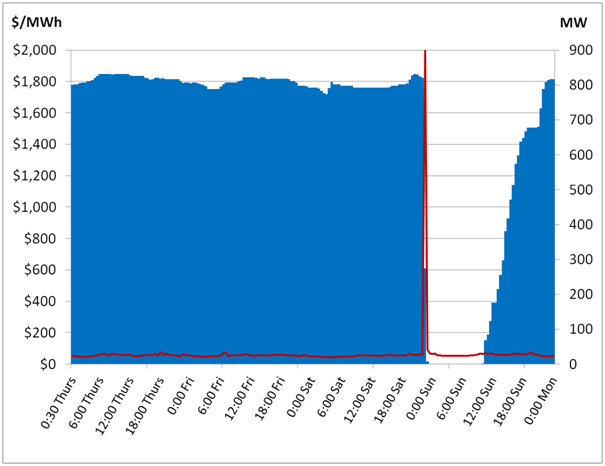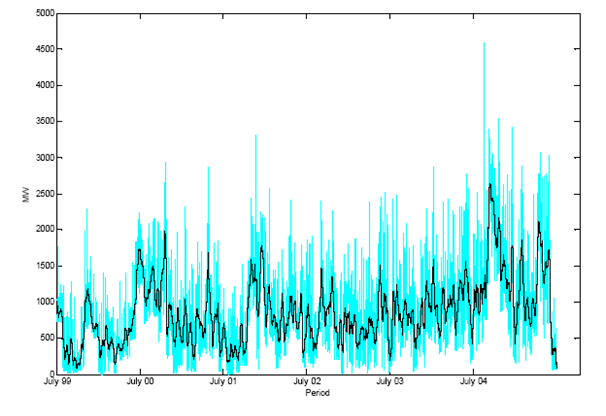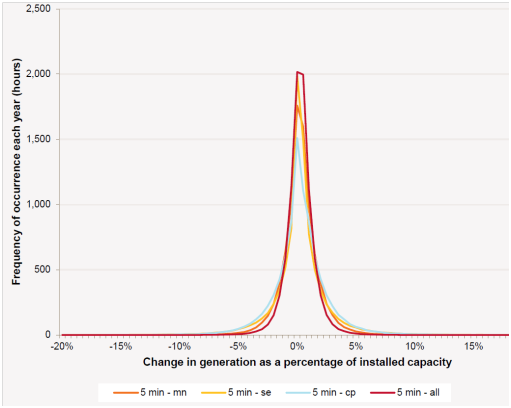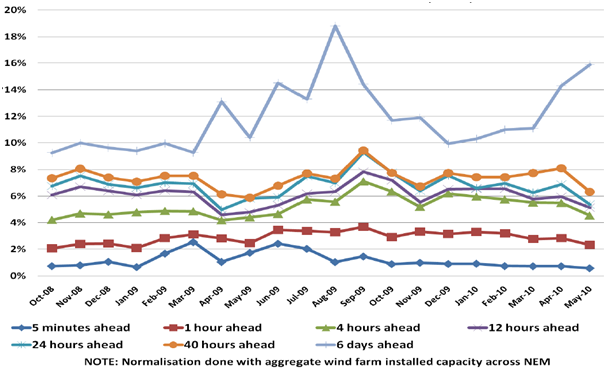Baseload vs Wind - a dumb argument
On Saturday night, the wholesale electricity market price skyrocketed in Queensland from $63 per megawatt-hour at 10:10pm to $11,499 at 10:15pm. What happened is illustrated in the chart below taken from NEM Review, although smeared into 30 minute intervals.
It serves as a lesson that the concept of ‘baseload’ power stations equalling reliability is hopelessly simplistic, and wind power’s variability is not some huge unprecedented issue for system reliability.
The solid blue is the sent-out generation of the Millmerran coal-fired power station in Queensland, and the red line is Queensland wholesale prices.
For Thursday, Friday and much of Saturday, Millmerran did what good old baseload generators are supposed to do – oscillating its output not all that far from about 800MW (scale on right hand of chart). But then in the space of just 5 minutes, 800 MW simply vanished for all intents and purposes. Consequently the red line of prices skyrocketed as other generators scrambled to replace the lost capacity (scale on the left-hand but, because data is smeared over 30 minutes, the extreme price of $11,499 is obscured).

To maintain a very high level of electricity supply reliability it is not a matter of simply having baseload power. No single power plant, irrespective of fuel type, is 100 per cent reliable – things invariably go wrong. Sometimes it might be a mechanical failure with the plant, or a power line fault, or even a fire or flood in a coal mine (both of which have afflicted Victorian brown coal generators).
So given the fact that no power station can deliver the 99 per cent reliability we want; we need to focus on the degree to which we can manage failures when they inevitably happen. This comes down to three factors:
1) The size of generating capacity loss;
2) The speed of that capacity loss; and
3) The ability to predict the loss in advance.
Because thermal power plants take time to ramp-up output, the smaller, slower and more predictable the loss of generating capacity, the easier it is to bring on other plant to replace any loss. The Millmerran event scores badly on all these counts: 800MW, lost within 5 minutes and completely unable to have been predicted. But note prices still managed to recover to low levels quite quickly.
This is not an isolated case as shown in the chart below. No it’s not the wind farm output in northern Germany. It is the amount of power station capacity out of action in the National Electricity Market due to unexpected failures of some kind (known as forced outages). Losses of capacity spiking up by several thousand megawatts within a day are common.
Capacity subject to forced outages across the NEM

Source: ROAM Consulting prepared for NEMMCO (now AEMO)
There’s no point pretending that wind power is the perfect source of power. Unfortunately it’s subject to the vagaries of the wind which aren’t all that well correlated with electricity demand. But within the very short five minute time period you aren’t exposed to any greater risk of large, sudden losses of generation capacity than coal power plants.
That’s because wind power turbine units are much smaller than coal units (3MW or less versus around 200 to 750MW for coal), and wind farms are smaller than coal power plants (rarely above 200MW vs 1000 to 2000MW for coal). Therefore you don’t get the same dramatic losses of generating capacity when something goes wrong.
If we take the example of South Australia, where there is 1205MW of wind installed, AEMO found that the maximum loss of capacity within a five minute period was 294MW, or about a 25 per cent drop.
Also such large short-term variations are extremely rare. The chart below illustrates that South Australian wind power very rarely experiences changes in output greater than 5 per cent of installed capacity within a five minute period (each line represents a different region with the red representing all wind farms aggregated across SA).
Change in wind power output within 5 minute period as proportion of installed capacity

Source: AEMO (2012) South Australian Wind Study Report 2012
Now on top of this wind has another advantage relative to a coal plant outage – changes in output can be predicted quite accurately several hours ahead.
The chart below shows the forecasting error for the NEM Wind Energy Forecasting System at different time periods in advance. Even 24 hours ahead the system’s level of error is less than 10 per cent. This allows other generators to receive plenty of notice about major losses of wind output and get themselves ready to fill any gaps.
NEM-wide forecasting error for the Wind Energy Forecasting System – Oct 2008 to May 2010 (Normalised mean absolute error)

Source: AEMO (2010) Australian Wind Energy Forecasting System (AWEFS) overview
No power source is perfect: Gas can be quick but is expensive; hydro is even quicker but highly constrained by rainfall; coal is cheap but big and slow plus highly polluting.
Wind is plentiful, free of pollution, but not controllable. However it is predictable, and the rate of change in output is something we are already used to managing.
















